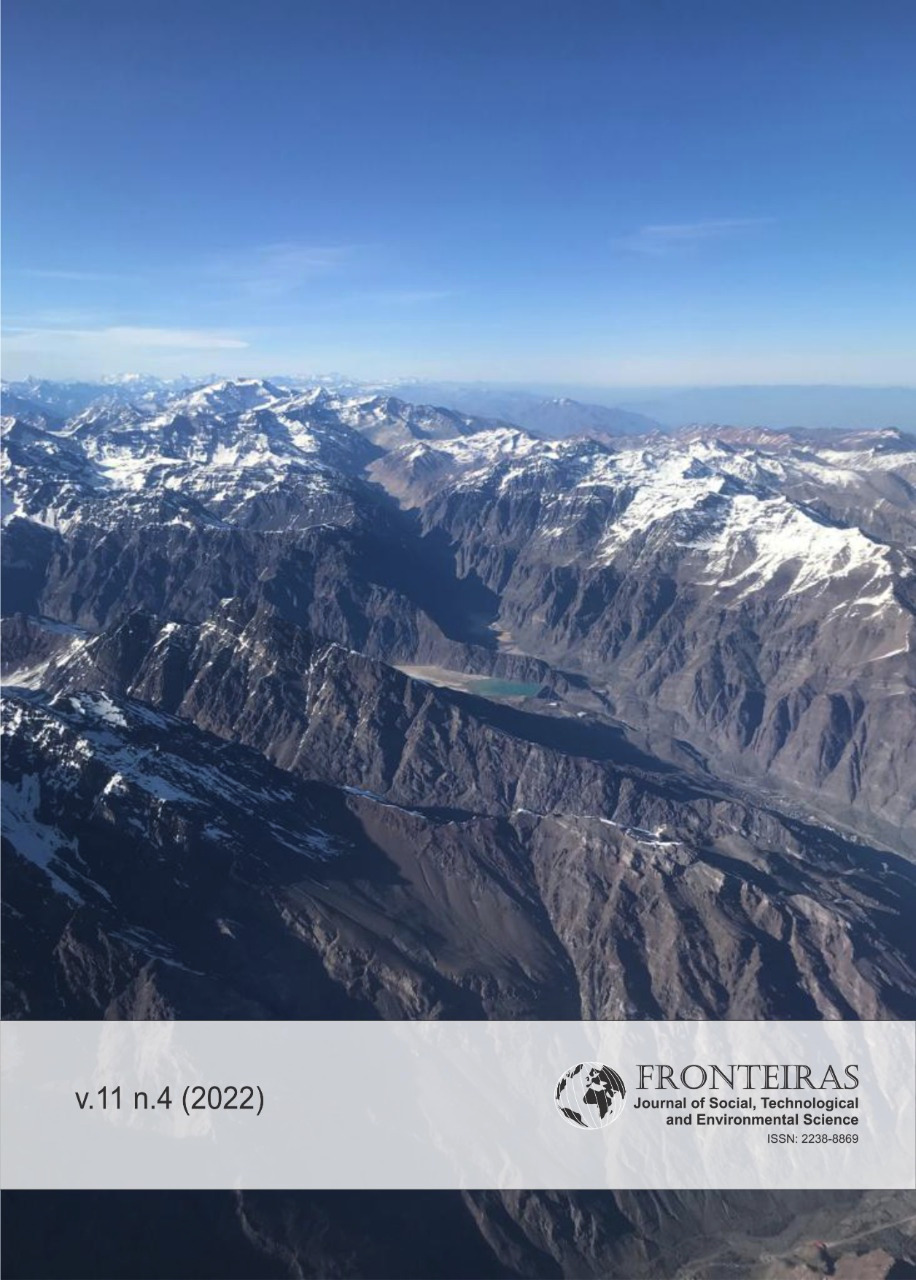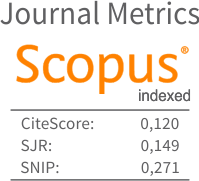Link between Urban Forests and Poverty: a Case of Study in a City of Argentina
DOI:
https://doi.org/10.21664/2238-8869.2022v11i4.p67-84Palavras-chave:
silvicultura urbana, índice de vegetação de diferença normalizada, temperaturaResumo
A silvicultura urbana é considerada um indicador positivo do meio ambiente de uma cidade, pois fornece muitos serviços positivos para as comunidades locais. Porém, nem todos os moradores podem se beneficiar, principalmente em áreas onde as árvores não são de vegetação nativa, como é o caso de Mar del Plata (Argentina). Nesta pesquisa, uma abordagem integrada combinando dados do censo e imagens de satélite mostra que os residentes de uma área residencial arborizada em Mar del Plata com boas condições socioeconômicas se beneficiam com um Índice de Vegetação por Diferença Normalizada (NDVI) mais alto e temperatura mais baixa do que a maioria das partes da cidade.
Referências
Barona C, Devisscher T, Dobbs, C, Aguilar L, Baptista M, Navarro N, et al 2020. Trends in urban forestry research in Latin America & the Caribbean: a systematic literature review and synthesis. Urban Forestry & Urban Greening 47: 126544. https://doi.org/10.1016/j.ufug.2019.126544
Barros J, Alves Jr S 2003. Simulating Rapid Urbanisation in Latin American Cities. In: Longley P, Batty M. Advanced Spatial Analysis: The Case Book of GIS. London, ESRI Press, London, p. 129-14.
Camilloni I, Barrucand M 2012. Temporal variability of the Buenos Aires, Argentina, urban heat island. Theoretical and Applied Climatology 107(1-2):47-58. https://doi.org/10.1007/s00704-011-0459-z
Caves R 2004. Encyclopedia of the City. Routledge, London, 594 p.
Chavez P. (1996). Image-Based Atmospheric Corrections – Revisited and Improved. Photogrammetric Engineering and Remote Sensing, 62, 1025-1036.
Celemin J, Velazquez , G 2018. Spatial analysis of the relationship between a life quality index, HDI and poverty in the province of Buenos Aires and the autonomous city of Buenos Aires. Argentina, Social Indicators Research 140(1): 57-77. https://doi.org/10.1007/s11205-017-1777-z
Congedo, L. (2016). Semi-Automatic Classification Plugin Documentation, DOI: http://dx.doi.org/10.13140/RG.2.2.29474.02242/1
Dwyer J, MC Pherson E, Schroeder H, Rowntree, R 1992. Assessing the benefits and costs of the urban forest. Journal of Arboriculture 18:227-234.
Escobedo F, Nowak D, Wagner J, De La Maza C, Rodríguez M, Crane D, Hernández J 2006. The socioeconomics and management of Santiago de Chile’s public urban forests. Urban Forestry and Urban Greening 4:105-114. https://doi.org/10.1016/j.ufug.2005.12.002
Fan C, Johnston M, Darling L, Scott L, Liao F 2019. Land use and socio-economic determinants of urban forest structure and diversity. Landscape and urban planning 181(10-21)
https://doi.org/10.1016/j.landurbplan.2018.09.012
Feres J, Mancero X 2001. El método de las necesidades básicas insatisfechas (NBI) y sus aplicaciones a América Latina, Series Estudios Estadísticos y Prospectivos. CEPAL Santiago de Chile, 54 p.
Figuerola P, Mazzeo N 1998. Urban-rural temperature differences in Buenos Aires. International Journal of Climatology 18(15): 1709–1723. https://doi.org/10.1002/(SICI)1097-0088(199812)18:15<1709::AID-JOC338>3.0.CO;2-I
Gangopadhyay P, Van Der Meer F, Van Dijk P, Saha, K 2012. Use of satellite-derived emissivity to detect coalfire-related surface temperature anomalies in Jharia coalfield, India. International Journal of Remote Sensing 33(21):6942-6955. https://doi.org/10.1080/01431161.2012.695093
Hassan A, Belal A, Hassan M, Farag F, Mohamed, E. 2019. Potential of thermal remote sensing techniques in monitoring waterlogged area based on surface soil moisture retrieval. Journal of African Earth Sciences 155: 64-74. https://doi.org/10.1016/j.jafrearsci.2019.04.005
Hidalgo R, Borsdorf A, Zunino H 2008. Las dos caras de la expansión residencial en la periferia metropolitana de Santiago de Chile: precariópolis estatal y privatópolis inmobiliaria. In Pereira P, Hidalgo R. Producción inmobiliaria y reestructuración metropolitana en América Latina, FAUSP-USP-PUC: Santiago de Chile, pp. 167–195.
Instituto Nacional De Estadística Y Censos (2012). Censo nacional de población, hogares y viviendas 2010. Censo del Bicentenario (Serie B No. 2. Resultados definitivos). INDEC Buenos Aires, 378 p. https://www.indec.gob.ar/ftp/cuadros/poblacion/censo2010_tomo1.pdf.
Iverson L , Cook, E 2000. Urban forest cover of the Chicago region and its relation to household density and income. Urban Ecosystems 4:105–124. https://doi.org/10.1023/A:1011307327314
Jensen R, Gatrell J, Boulton J, Harper B 2004. Using remote sensing and geographic information systems to study urban quality of life and urban forest amenities. Ecology and Society, 9(5) [online] URL: http://www.ecologyandsociety.org/vol9/iss5/art5/
Kamma J, Manomaiphiboon K, Aman N, Thongkamdee T, Chuangchote S, Bonnet, S 2020. Urban heat island analysis for Bangkok: multi-scale temporal variation, associated factors, directional dependence, and cool island condition. Science Asia 46:213-223. htpp:// 10.2306/scienceasia1513-1874.2020.024
Kinzig A, Warren P, Martin C, Hope D, Katti M 2005. The effects of human socioeconomic status and cultural characteristics on urban patterns of biodiversity. Ecology and Society, 10(1) https://doi.org/10.5751/ES-01264-100123
Malek E, Bingham G 1997. Partitioning of radiation and energy balance components in an inhomogeneous desert valley. Journal of Arid Environments 37:193-207. https://doi.org/10.1006/jare.1997.0279
Mc Pherson E, Nowak D, Heisler G, Grimmond S, Souch C, Grant R, Rowntree, R 1997. Quantifying urban forest structure, function, and value: the Chicago Urban Forest Climate Project. Urban ecosystems 1(1):49-61. https://doi.org/10.1023/A:1014350822458
Menni, J 2006. Socioeconomic-Vegetation Relationships in Urban, Residential Land: The Case of Denver, Colorado. Photogrammetric Engineering & Remote Sensing 72: 911–921. https://doi.org/10.14358/PERS.72.8.911
Montagu C 2005. Una propuesta para el desarrollo turístico del Bosque de Peralta Ramos. Universidad Abierta Interamericana, Buenos Aires, 96 p. http://imgbiblio.vaneduc.edu.ar/fulltext/files/TC059958.pdf
Nichol P 2009. Constructing connections: urban forestry and Toronto´s west don lands revitalization. Environnement urbain/ Urban environment 3: 83-93. https://doi.org/10.7202/037602ar
Nichol J, Wong M 2005. Modeling urban environmental quality in a tropical city. Landscape and Urban Planning 73:49–58. https://doi.org/10.1016/j.landurbplan.2004.08.004
Oshio H, Chen K, Asawa T 2020, Airborne and Terrestrial Observations of the Thermal Environment of Urban Areas Surrounding a High-Rise Building during the Japanese Winter. Sensors, 20(2):517. https://doi.org/10.3390/s20020517
Pedlowski M, Carneiro Dasilva V, Adell J, Heynen N 2002. Urban forest and environmental inequality in Campos dos Goytacazes, Rio De Janeiro, Brazil. Urban Ecosystems 6:9–20. https://doi.org/10.1023/A:1025910528583
Salbitano F, Borelli S, Conigliaro M, Chen Y 2016. Guidelines on urban and peri-urban forestry. Food and Agriculture Organization, Rome, 172 p.
Santana Rodríguez L, Escobar Jaramillo L, Capote P 2010. Estimación de un índice de calidad ambiental urbano, a partir de imágenes de satélite. Revista de Geografía Norte Grande 45:77-95. http://dx.doi.org/10.4067/S0718-34022010000100006
Steenberg J, Millward A, Duinker P, Nowak D, Robinson P 2015. Neighbourhood-scale urban forest ecosystem classification. Journal of environmental management 163:134-145. https://doi.org/10.1016/j.jenvman.2015.08.008
Stutz S, Tonello, M, González Sagrario, M, Navarro D, Fontana S 2014. Historia ambiental de los lagos someros de la llanura Pampeana (Argentina) desde el Holoceno medio: inferencias paleoclimáticas. Latin American Journal of Sedimentology and Basin Analysis 21(2):119-138.
Szantoi Z, Escobedo F, Wagner J, Rodriguez J, Smith S 2012. Socioeconomic factors and urban tree cover policies in a subtropical urban forest. GIScience & Remote Sensing 49(3): 428-449. https://doi.org/10.2747/1548-1603.49.3.428
Valladares L, Coelho, M 1995. Urban Research in Latin America. Management of Social Transformations, Discussion Paper Series – 4, UNESCO, [online] URL: http://digital-library.unesco.org/shs/most/gsdl/cgi-bin/library?e=d-000-00---0most--00-0-0--0prompt-10---4------0-1l--1-en-50---20-about---00031-001-1-0utfZz-8-00&a=d&c=most&cl=CL4.1&d=HASH01d153a04aa116d24ee25897
Velázquez G., Celemín, J. (2011), Aplicación de un índice de calidad ambiental a la región Pampeana Argentina (2010). Finisterra - Revista Portuguesa de Geografia, 91, 47-64. https://doi.org/10.18055/Finis1324
Yang, C., Wang, R., Zhang, S., Ji, C., & Fu, X. (2019). Characterizing the hourly variation of urban heat islands in a snowy climate city during summer. International journal of environmental research and public health, 16(14), 2467. https://doi.org/10.3390/ijerph16142467
Weng, Q. (2001). A remote sensing-GIS evaluation of urban expansion and its impact on surface temperature in the Zhujiang Delta, China. International Journal of Remote Sensing, 22(10),1999-2014. https://doi.org/10.1080/713860788
Downloads
Publicado
Como Citar
Edição
Seção
Licença
Esta revista oferece acesso livre imediato ao seu conteúdo, seguindo o princípio de que disponibilizar gratuitamente o conhecimento científico ao público proporciona maior democratização mundial do conhecimento.
A partir da publicação realizada na revista os autores possuem copyright e direitos de publicação de seus artigos sem restrições.
A Revista Fronteiras: Journal of Social, Technological and Environmental Science segue os preceitos legais da licença Creative Commons - Atribuição-NãoComercial 4.0 Internacional.


